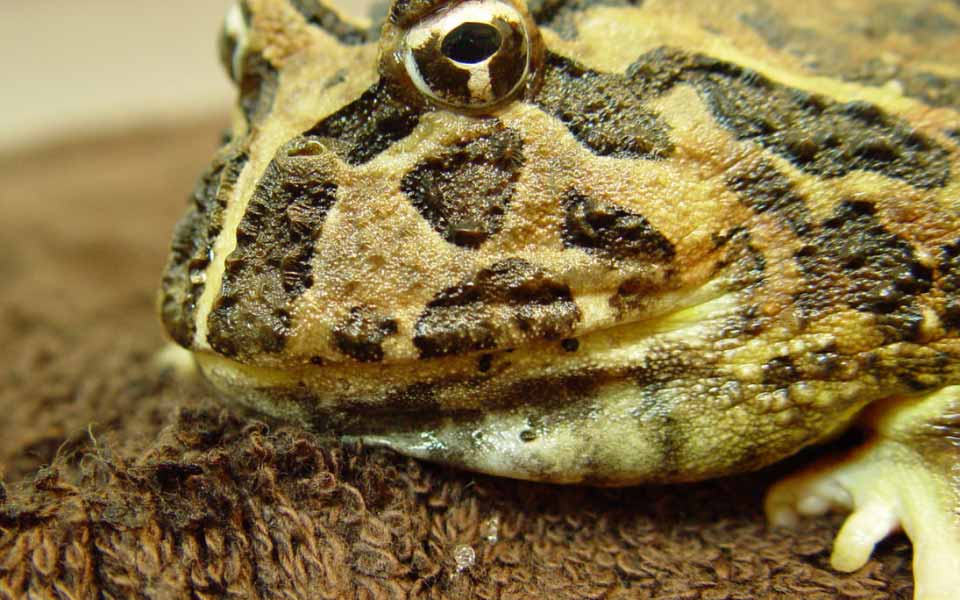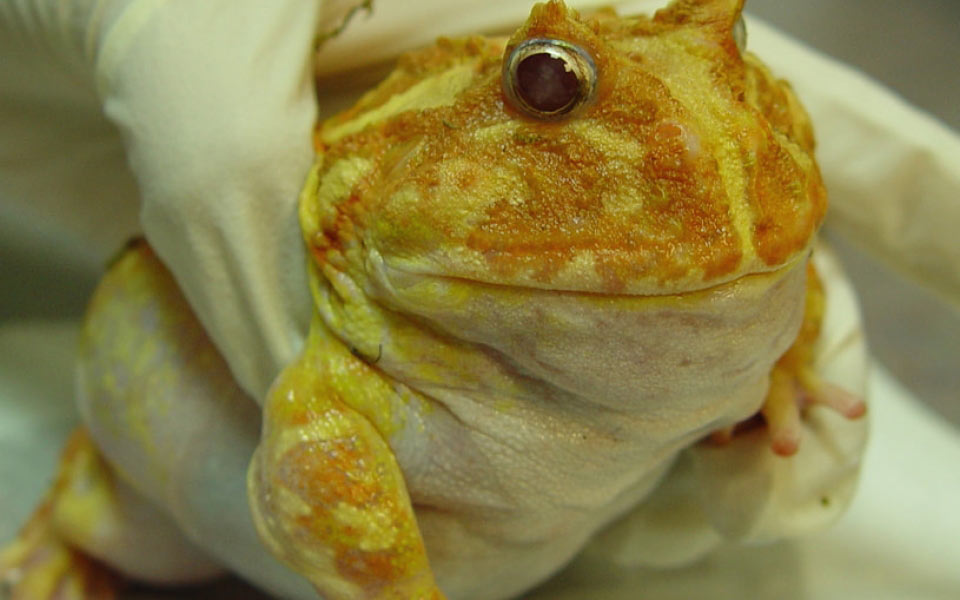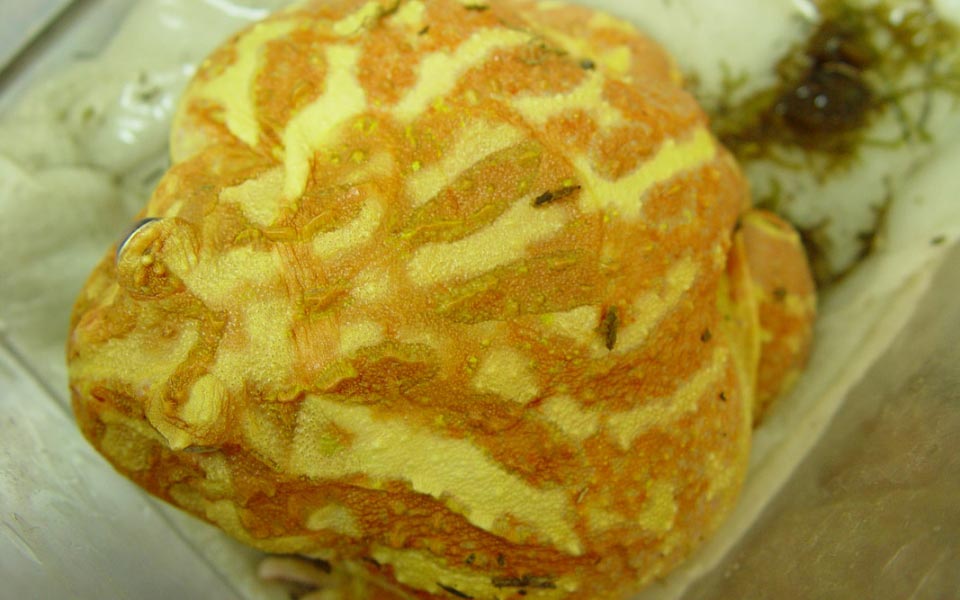(Ornate Horned Frog, Wide Mouth Frog, Pacman Frog, Bell Horned Frog)
Erica Mede, CVT
|
Enclosure Style
|
Semi-Aquatic
|
|
Natural Habitat
|
Grasslands near shallow fresh water in Argentina, Uruguay, and Brazil
|
|
Diet Style
|
Insectivores and opportunistic carnivores
|
|
Life Span
|
7-10 years
|
|
Size
|
4-6 inches
|
|
Temperature Range
|
Ambient: 76-82 F, Basking/Hot Spot: 84-88 F, Water 74-78 F
|
|
UVB Requirement
|
Yes
|
|
Permits Required
|
None in Illinois
|




Disclaimer: This information is intended to be used as a care guide. This is not a definitive source on the care for this species and should be used in conjunction with the experience of knowledgeable keepers, professionals, and further research. Ranges mentioned are for reference and are not absolutes.
Factoids:
- The mouth accounts for roughly half the body size!
- This species was discovered in 1824 by Alexander Maximilian, a German naturalist.
- Horned frogs do not have the traditionally long tongues that most people think about when they think of frogs.
Enclosure:
- Aquariums: An adult can also be kept comfortably in a 20 gallon enclosure. It is recommended to utilize front opening enclosures whenever possible.
- Hatchlings and Young Frogs: 5 gallon enclosure or similar sized enclosures are a great start for young frogs.
- Ventilation: Humidity is important and so is appropriate ventilation for this species! Air circulation will not only improve humidity cycles but will prevent health issues from stagnant air and oppressive humidity.
- Co-Habitation: Pacman frogs will attempt to eat one another generally if not fed enough or the size difference is too large.
Water Quality:
- Water Changing: Change water daily! If water is standing in the enclosure, a filtration system is warranted.
- Water Quality: Use chlorine free water (a dechlorinator or water that has been sitting open for 24 hours), infant water, or spring water. Avoid distilled water.
- Water Depth: This species does not swim well! Keep the water shallow enough that your frog will not be required to swim in it. Room temperature water.
Substrate:
- Spartan Tank: Recommended to prevent build up of organic debris and accidental ingestion of substrate. Soaked terry cloth towels or paper towel.
- Aesthetic Substrate: Top soil, coconut husk, damp peat moss, untreated soil, bark substrates, coir, or sphagnum moss make exceptional substrates. These must be spot cleaned daily, agitated daily, and changed weekly. If particulate bedding is used, it is advisable to feed in a separate container or offer insects in a dish to avoid accidental ingestion of bedding. Mosses are an excellent way to control humidity. They do require diligence but will offer beautiful enclosures and exceptional humidity retention. The substrate should be wet but not so wet that you can wring water from it. These must be spot cleaned daily, agitated daily, and changed weekly. If particulate bedding is used, it is advisable to feed in a separate container or offer insects in a dish to avoid accidental ingestion of bedding. Mosses are an excellent way to control humidity. They do require diligence but will offer beautiful enclosures and exceptional humidity retention. Clay balls at the bottom of an enclosure covered by a particulate substrate will also dramatically increase the humidity of an enclosure.
Temperature & Lighting:
- Thermometers: One thermometer should be placed on the warm end an inch above the substrate and the other an inch above the substrate on the cool end of the enclosure.
- Infrared Temperature Gun: These are strongly recommended and encouraged for keeping any animal. It is strongly recommended to purchase these inexpensive hand held tool to identify actual temperatures at various locations in the enclosure. A thermometer at the height of a basking platform may say 95 degrees and the temperature gun will indicate that the glass the thermometer is on is 95 degrees but the basking platform directly under the light is 130 degrees! Likewise, this can help you monitor your pet’s POTZ, preferred optimal temperature zone, and help watch for trends in behavior that correlate with temperature variation.
- Thermostats: Thermostats save lives and money. Always use a thermostat when a heating element is used. We recommend HerpStat by SpyderRobotics. Under tank heaters, heat cable (outside the enclosure not in the enclosure), heat tape, heat bulbs, and ceramic heat emitters can all be utilized to maintain air temperature. A mesh screen can be added around light fixtures to prevent accidental exposure. Never use heat cable in enclosures or hot rocks.
- UVB Lighting: A Zilla Pro-Series Tropical 25 or ZooMed 5.0 is recommended.
Enrichment:
- Hides: A hide can be made with a half log, clay flower pot, PVC, etc. Get creative!
- Adjusting the cage furnishings once in a while is recommended for enrichment.
- Live plants can be easily uprooted by these powerful diggers and should be potted separately if placed in the enclosure. Fake foliage such as silk leaves can be used without problems and pose the benefit of being easily cleaned.
- Leaves from outside should be avoided to prevent accidental introduction of fungus into the enclosure.
- Adjusting the cage furnishings every 2-3 months is recommended for enrichment.
- Target Training: Many reptiles are target trainable and arguably all animals can be target trained. YouTube proves invaluable here for learning! Visit a local zoo and talk with the docents or keepers as well about their target training!
- YouTube, reptile forums, and sites such as Pinterest offer suggestions and great ideas on different enclosure decor and enrichment options!
Feeding
- Dietary guidelines are just that, they are not hard and fast rules. Offer a variety of food items to provide enrichment, maintain ideal nutrition, and to learn more about the species you are keeping!
- Free Range (Wild) Diet: An opportunistic ambush predator that will consume rodents, small reptiles, large spiders, and locust.
- Captive Diet: A varied diet rich in crickets, meal worms, roaches, earthworms, horn worms, and silk worms is recommended. Earthworms should make up the majority of your pet’s diet. Occasional pinky mice can be offered as well.
Sources and Suggested Reading
- The Horned Frog Family and the African Bullfrogs, Richard Bartlett, Patricia Bartlett
- Horned Frogs, Ray Hunziker, Raymond E.Hunziker, R. Hunziker
- Quick & Easy Horned Frog Care, Allen R. Both

